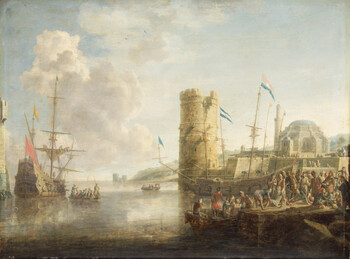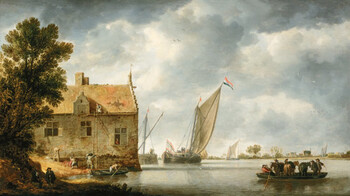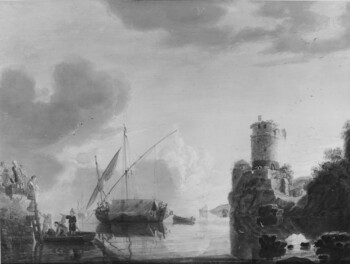11.500 €
A group of men of diverse origins swimming in a harbour
Oil on panel : 24,4 X 34,0 cm
Monogrammed lower right on the quay “BP”
Frame : 39,0 X 48,8 cm
In short
This is an exceptional painting, showing a very rare subject during the 17th century, swimmers in transparent waters: you may actually see their movements under water. Very few paintings with swimmers are still in private hands, most of them sit in important museums.
Bonaventura Peeters I was one of the most important Flemish marine painters. In a short, but prolific career he painted very diverse maritime subjects, set locally, but also in the Mediterranean, in N. Europe, on the coasts of N. Brazil, etc. As you can see, he was also an excellent figure painter.
About Bonaventura Peeters I
Flemish painter
Antwerp 1614 – Hoboken 1652
Important marine painter.
Probably a pupil of the Flemish painter Andries van Eertvelt and later of the Dutch painter Simon de Vliegher.
Brother of Gillis I (1612 – 1653), Catharina (1615 – after 1676) and Jan I (1624 – 1677 or 1680), all three painters. The famous Antwerp still life painter Clara Peeters (1594 – after 1654) was no relation.
Master of his sister Catharina, of his brother Jan I, of and possibly of his nephew Bonaventura II (1641 – 1702, son of Gillis I).
Bonaventura I and Gillis I became masters in the Painters’ Guild of Saint Luke in Antwerp in 34/35. They probably shared a studio. In 1639 they collaborated on “the siege of Calloo” commissioned for the Town Hall of Antwerp.
Bonaventura I was a prolific and extremely versatile painter of maritime subjects. According to Rupert Preston his intimate and accurate knowledge of ships hint at an early life spent at sea. Typical of Peeters is his detailed depiction of clouds and waves.
He was also a very good figure painter, to such a degree that he collaborated with both Pieter Neeffs the Elder and the Younger, painting the staffage in some of their church interior scenes (for example in the signed examples in the National Gallery of London and in the Kunsthistorisches Museum of Vienna).
Peeters’ earliest marine paintings are panoramic views.
But he rapidly evolved towards the more modern, typically Dutch tonal style of painting: realistic, monochrome, but very lively maritime subjects,
from calm waters to dramatic storms.
By the end of the 1630s fashion changed and stronger colours reappeared.
Our painter did not restrain himself to painting the North Sea or the river Scheldt, although these subjects form the bulk of his artistic production.
He painted some views of Brazil, for which he is said to have relied on descriptions by his brother Gillis I, who had travelled to South America. Between 1630 and 1654 the Dutch colonized and controlled Northern Brazil; their capital was Recife. They finally lost Dutch Brazil to the Portuguese.
Other unusual subjects by Peeters are views from the coast of Northern Europe. Best known is his depiction of the port of Archangel(sk) in Northern Russia with sledges pulled by reindeers or elks (Greenwich, National Maritime Museum). Archangel(sk) was the chief seaport of Russia until the creation of Saint Petersburg. While this view is fanciful other depictions of Scandinavian ports and landscapes seem so realistic that it is thought Bonaventura might have travelled there.
Finally we must mention Peeters’ last exotic subjects: Levantine (and a few Spanish) harbour views. These Mediterranean views are decorative, poetic interpretations of engravings, drawings and paintings of other artists, not realistic views of regions that he travelled to. It is generally accepted that Peeters could not have travelled there: our painter died at the age of 38, unmarried, suffering the last years of his life from an ill health, living in Hoboken, just South of Antwerp on the river Scheldt, together with his sister Catharina and possibly with his younger brother Jan I. It is actually this brother, Jan, who travelled in the Mediterranean and published several sets of engravings made after his topographical drawings.
Over a career that did not even span twenty years Peeters painted a large and extremely varied number of maritime subjects. During most of his short life Holland was fighting Spain (and thus Flanders that still belonged to the Spanish Habsburg dynasty) to secure its independence. The Eighty Years’ War only ended in 1648, four years before Peeters’ death, with the Peace of Westphalia and the final recognition by Spain of an independent Dutch Republic. Flanders remained Spanish. Against this political background it is rather striking that the overwhelming majority of the ships in Peeters’ paintings fly Dutch flags. He must have worked mainly for a Dutch public.
Bonaventura Peeters I also produced drawings and engravings with maritime subjects. One of them, “Ships in a storm”, today in the Plantin-Moretus Museum in Antwerp, has a poem by him on its back. Here the artist compares the dangers at sea with the dangers that man has to face over a lifetime.
About our painting
This is an exceptional painting for two reasons:
- Two men are swimming in transparent waters; we see not only their heads sticking out of the water, but also their swimming movements in the clear water. There are very few 17th century Flemish or Dutch paintings known with people swimming or having a good time in the water. On these rare paintings you only see their heads and shoulders sticking out of the water.
- Of the eight men represented in the foreground three have a darker skin than the others. Could they be of Arabic or Turkish origin?
Why should you buy this painting?
Because in this small, but exceptional composition we see people of diverse origins swimming together in clear harbour waters.
Comparative paintings
Click photos for more details













